What Does Parsley Taste Like?
Parsley is so popular around the world, but what does parsley taste like? It is usually used as a garnish to decorate the final dish, but it also does a great job of enhancing the flavor of some dishes. So what taste does parsley add to your dish?
In this very post, I will give you some information about this amazing herb as well as its taste and the ways to use it as creatively as you can! Sounds interesting, huh? Let’s get started right now!
But before that, maybe you should take a look at the basic information about parsley!
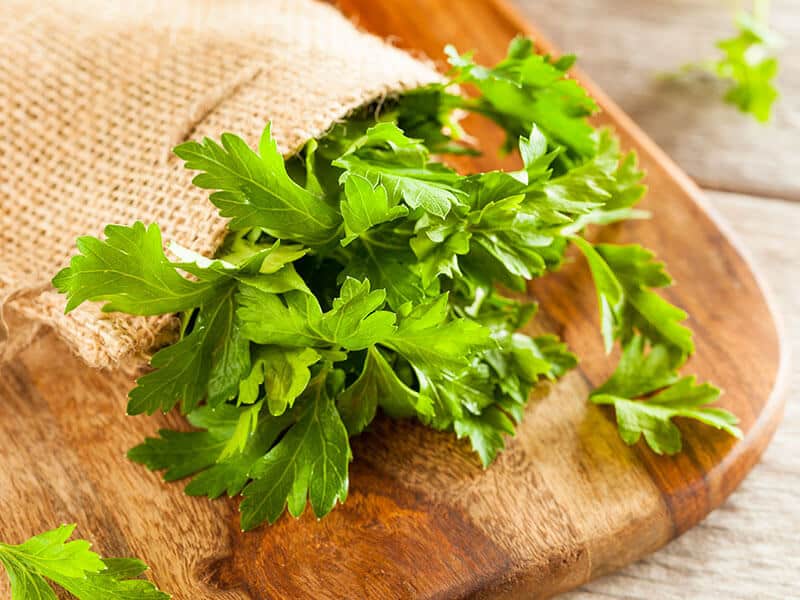
Something You May Not Know About Parsley
Parsley, or also called garden parsley, is a member of the Apiaceae family. It originates from the Mediterranean region. It is a biennial plant that grows yellow flowers every two years. Nowadays, parsley is commonly cultivated globally as a culinary herb or vegetable.(1)
Parsley is an extremely famous herb around the world! You can find it in any local market, supermarket, or herb store near your house. For culinary purposes, it is used widely in European, Asian, and American cuisines as an ornament or spice to boost the dish’s flavors.
Sometimes, parsley is so popular as a simple garnish on top of the dish that people forget about its flavor. It actually tastes mild to strong depending on the specific types. It is also easy to grow at home, so why not plant some parsley seeds in your garden!
Learn how to grow parsley from seeds to fulfill your lovely garden!
The Taste Of Each Parsley Type
In general, parsley tastes bright, clean, peppery, earthy, and aromatic. However, parsley varies in taste because there are many types and varieties of it. The two most common species of parsley are curly-leaf and flat-leaf parsley with distinctive characteristics.
The appearance and flavor of each parsley type are different and unique. So here’s a brief table for you to see how different they are between some common kinds of parsley!
Curly-Leaf Parsley
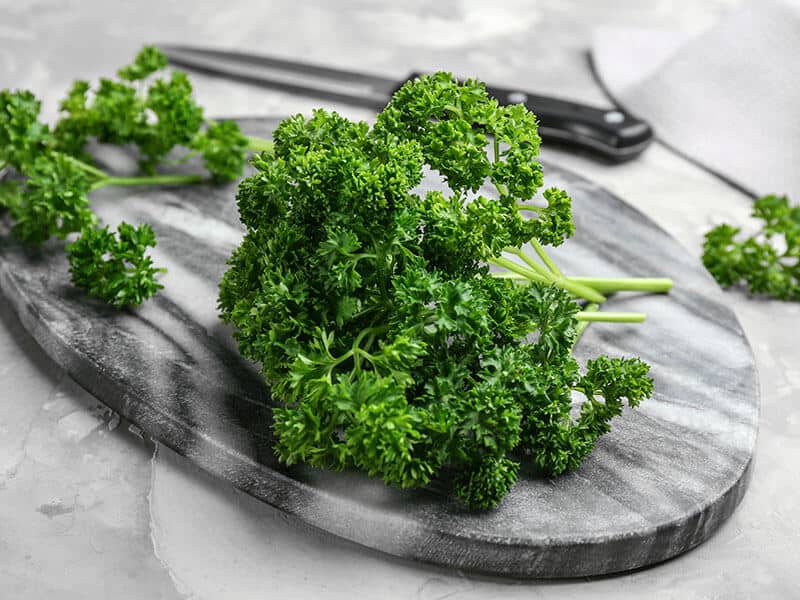
Curly-leaf parsley has a mild and hard-to-recognize taste that is usually used as a garnish or decoration on top of a completed dish. It is used widely in many parts of Europe and Western Asia. Like the name, this parsley type has beautiful curly, ruffled green leaves.
This standard French parsley is so popular as a garnish that most of you may see it on top of a typical restaurant meal. It does not add any specific taste to the dish, and people often discard it before enjoying the dish.
The two most common varieties of curly-leaf parsley are Forest Green parsley and Extra Curled Dwarf parsley. They are all versatile and easy to grow. Use fresh chopped curly-leaf parsley to garnish your dish!
Flat-Leaf Parsley (Italian Parsley)
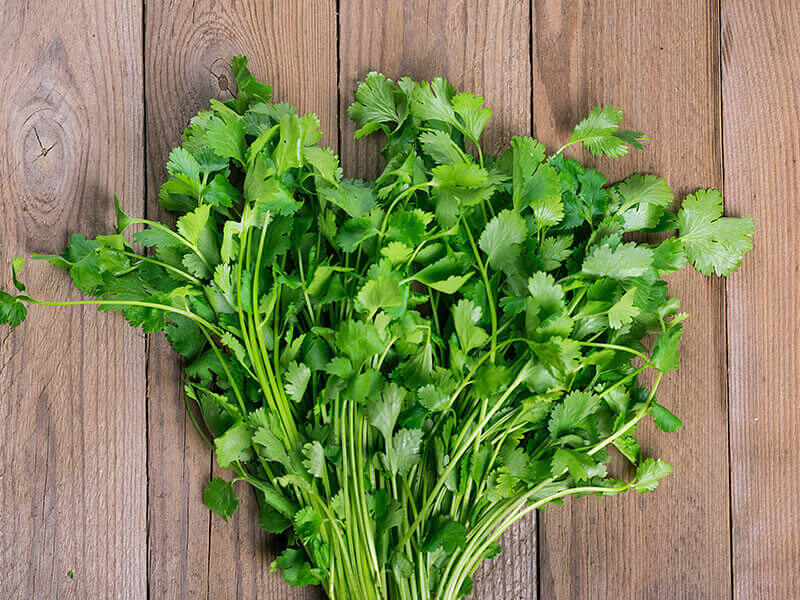
The flat-leaf parsley is one of the tallest parsley types. Italian flat-leaf parsley looks so much like cilantro that people usually can’t tell them apart, although they are very different in taste. It also has a dark green color.
Flat-leaf parsley is more robust and flavorful than the curly type; thereby, it’s usually used to enhance the dish’s original taste rather than decorate it. This parsley is also more tolerant and easier to grow than the curly one, so the gardeners prefer it.
Japanese Parsley (Mitsuba Parsley)
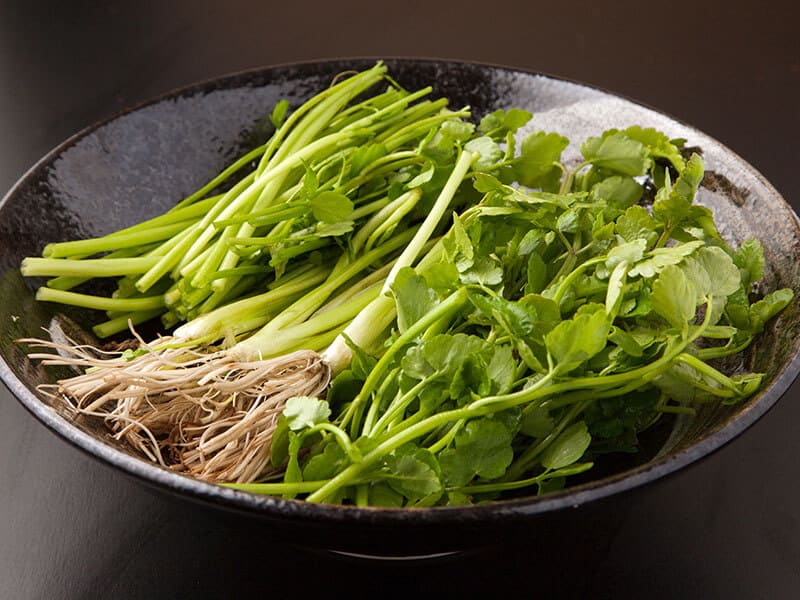
Japanese parsley comes from Eastern Asia. Every part of this parsley is edible and can be cooked in different ways. The leaves and roots are used as veggies or garnish; the seeds can be used as a spice.
Its taste can be described as celery-like with a slightly bitter note. It looks pretty like the flat-leaf parsley with larger and rounder leaves. As the name suggests, it is widely used in Japanese as well as Asian cuisines. It is usually used as a garnish in soups and stir-fries.
Root Parsley (Hamburg Parsley)
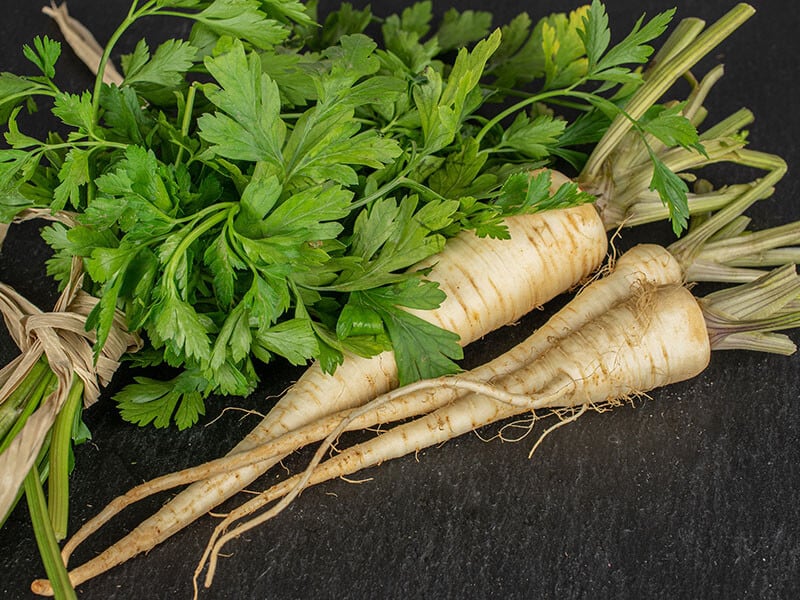
Root parsley, or also called Hamburg parsley, is grown to harvest the thick root. Its root looks like a kind of vegetable, such as carrot or parsnip. It’s more special than any other type of parsley because of the huge root that can be used as a culinary ingredient.
Root parsley is popular in central and eastern European cuisines. With the crunchy, fresh taste of the root, it is widely used as a vegetable in casseroles, soups, and stews. Its root can also be eaten raw as a fun snack, just like a carrot. What an interesting veggie, right?
About the dark green leaves of root parsley, you can also use them if you want. They look much like Italian flat-leaf parsley, but not as flavorful and versatile as them. The leaves can be used as a decoration for your dishes.
Dried Parsley
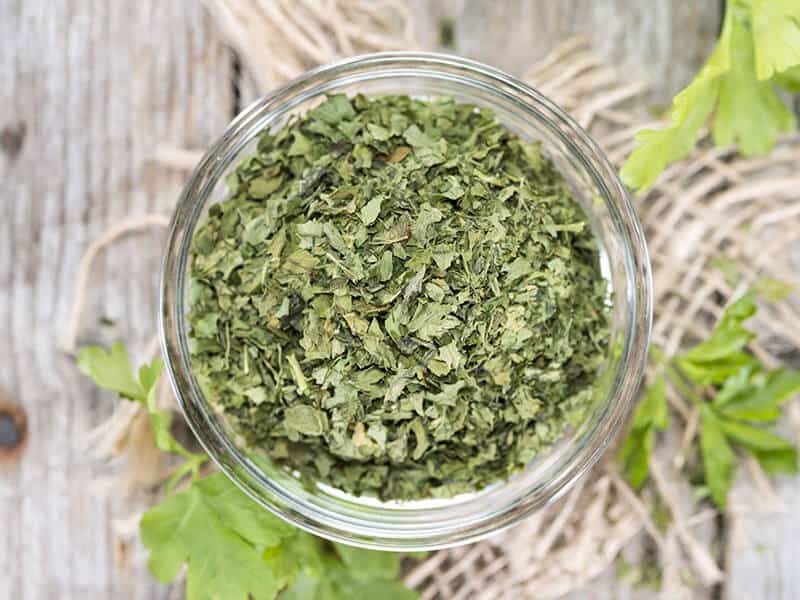
Dried parsley is one of the best sources of apigenin that can help prevent skin cancer. Since it is dried from fresh, the available apigenin is stimulated and develops, making it a superb healthy spice. (2)
The taste of dried parsley is bright, herbaceous with a bitter note. It is crushed into small pieces and contains a smoky green, yellowish color. Like other dried herbs, it can last longer than fresh parsley, but it is not commonly used as a spice.
Do you know how to dry parsley? This instruction video is very detailed and easy to follow!
Parsley is just like any other fresh herbs and leaves, which are easily rotten after only 1 to 2 days if you don’t do anything to them. So how to deal with the fresh parsley? Read the next section to find out the answer!
The Ultimate Method To Store Fresh Parsley
When you buy home a bunch of fresh parsley and can not use up all of them in one time, then how to store them for the next use? Read this step-by-step instruction to keep your parsley fresh for up to a few weeks!
What You Need To Prepare:
- Fresh parsley
- A knife and a cutting board
- Paper towel
- Jar or water glass
- Plastic bag(s)
- Water
Instructions:
Step 1: Prepare The Parsley.
Take your parsley out of the packaging and cut off all the bottom of the stems. The leaves should be dry. If they are wet, put them on a paper towel to get rid of the water. Make sure that your parsley is completely dry before the next step since it’s a key detail.
Step 2: Put the Prepared Parsley Into a Container With Water.
Pour the water into a jar or a glass until it reaches half of the container. Put the stem end part of the parsley into the jar/glass. Place them carefully so that they can stand.
Step 3: Cover the Leaf Part With a Plastic Bag.
Design your available plastic bag so that it can cover all the above part of the parsley. Put the bag on the parsley loosely, not wrap so tightly that the air cannot get into it.
Step 4: Place Them in a Refrigerator, or at Room Temperature.
Parsley can be stored in both ways, in the fridge or at normal temperature. But if I were you, I would preserve it in the fridge so that it can last a bit longer. If you leave them outside of the fridge, you can hardly control the heat sources and moisture.
Step 5: Change the Water in the Container if There’s Any Discoloration.
Remember to watch your stored parsley regularly, so that you can change the water whenever it turns into a yellowish liquid that is not good for storing fresh herbs.
Here are some other methods for you to keep your parsley fresh!
If you do it right, following this detailed instruction, your fresh parsley can incredibly last up to a few weeks, maintaining the same taste and smell as parsley from day one! Try this method now and share with me your result below the comment section!
Some Recipes That Make Parsley Shine Like A Star
Besides being a decorative element for a dish, parsley can also be the main ingredient that provides the key taste for some sauces and salad dressings. Note down these delectable recipes in your cookbook and make them someday!
Chimichurri Sauce
Chimichurri sauce is an easy-to-make Argentinian sauce with some fresh ingredients that don’t need to be cooked. Fresh flat-leaf parsley is the star of this dish, its taste plays an important role in the sauce. The sour flavor of vinegar also matters.
With just some components available right in your kitchen, you can make Chimichurri sauce within a few minutes by putting all of them into a blender and mixing them all together. This can be a delectable dipping sauce or marinade for your chicken!
Parsley Pesto
Parsley pesto is such a versatile condiment that can suit many dishes such as sandwiches, pizzas, pasta, etc. It’s pretty like the traditional basil green pesto, with the parsley in place of the basil.
Parsley pesto is a quick, convenient sauce that you can make a lot at once and store for long usage. It is tangy, garlicky, and cheesy! What’s more perfect than a steak with some parsley pesto on?
Tabbouleh Salad
Tabbouleh is a traditional grain salad from Lebanon, with many chopped herbs, veggies, and bulgur wheat. It’s nothing complicated to cook this salad. All you need to do is cook the bulgur wheat and chop the remaining ingredients. Then, mix them all together.
This can be a great breakfast or lunch for your children or even a delicious side dish on the table. It’s fresh, flavorful, and worth trying! You can also make it from leftovers to save more time. The recipe is so simple to prepare, don’t hesitate any longer!
Fascinating Health Advantages That Parsley Bring You
Although parsley is just a garnish or a spice to your dish, it actually benefits you with many incredible nutrients and health advantages! Check out some of them!
- Parsley is packed with minerals and vitamins, especially vitamin K. Consuming just one tablespoon of fresh parsley, you will fulfill 70% of vitamin K daily intake. How amazing is that?
- Parsley can help you improve bone and eye health. With all the vitamins packed inside, parsley is a great source of nutrients to support your bone and eye health. The vitamin A in parsley is really good for you to protect the eyes.
- Parsley can even prevent you from cancer. Dried or cooked parsley consists of flavone apigenin, which is a promising anticancer agent that can keep you away from cancer. (2)
Do these health benefits of parsley wow you? Add more of it in your next dishes to get all the available nutrients!
FAQs
I think that’s enough for you to know about the taste of parsley. But there may still be some other concerns that need a specific answer. So here you are, the quick questions and answers section!
Not Only A Garnish, But Also A Flavor Treat To Your Dish
After reading this post, have you imagined in your head about the taste of parsley? I think that you all have tasted parley before but maybe you did not notice it.
I have tried to provide you with a specific description about different types of parsley, so that you could easily compare them and choose the most suitable one for your next dish. Hope that you enjoy this informative post and if it’s helpful to you, please share it!
Also, comment below some of your concerns or sharings about culinary experiences on this wonderful herb and I will reply to all of them as soon as possible! Sharing is caring!
References
- En.wikipedia.org. 2021. Parsley – Wikipedia.
- WebMD. 2021. Health Benefits of Parsley.

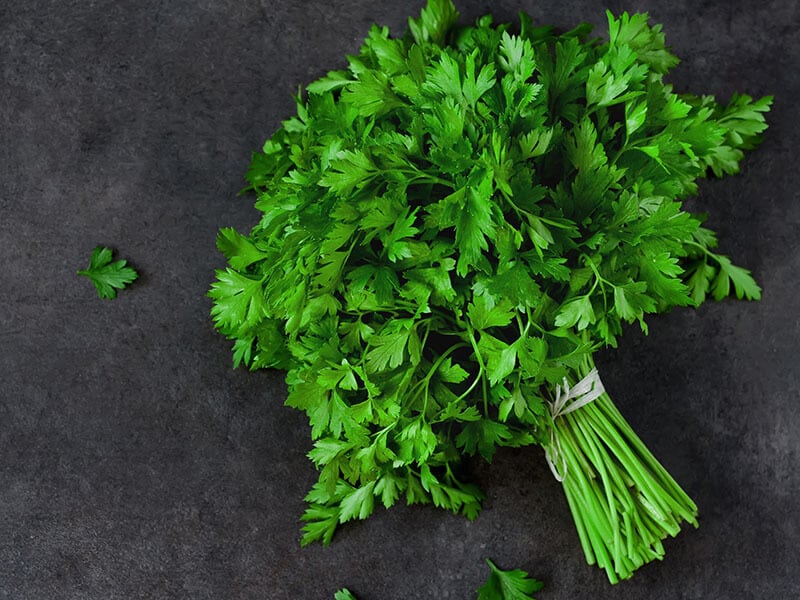
Liam O’Brien
Founder & Recipe Developer
Expertise
Education
Dublin Institute of Technology (now Technological University Dublin)
Ballymaloe Cookery School, County Cork, Ireland
Liam O’Brien is the co-founder and kitchen soul behind Good Tasting Meals, a chef who believes that cooking shouldn’t feel stressful or complicated.
He earned his culinary stripes at Technological University Dublin and polished his farm-to-table skills at Ballymaloe Cookery School. With over 15 years flipping pans and stirring up stories, Liam has worked in family cafés, bustling bistros, and everything in between.
At Good Tasting Meals, Liam brings you recipes that feel like home: cozy, simple, and full of flavor.